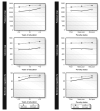Trends in black-white differentials in dietary intakes of U.S. adults, 1971-2002
- PMID: 17383557
- PMCID: PMC2001255
- DOI: 10.1016/j.amepre.2006.12.011
Trends in black-white differentials in dietary intakes of U.S. adults, 1971-2002
Abstract
Background: Disparities in the health status of blacks and whites have persisted despite considerable gains in improved health of the U.S. population. Tracking changes in black-white differentials in dietary attributes over time may help in understanding the contribution of diet to these disparities.
Methods: Data were used from four National Health and Nutrition Examination Surveys conducted between 1971 and 2002 for trends in self-reported intakes of energy, macronutrients, micronutrients, fruits and vegetables, and the energy density of foods among U.S. non-Hispanic black (n=7099) and white (n=23,314) men and women aged 25 to 74 years. Logistic and linear regression methods were used to adjust for multiple covariates and survey design.
Results: Energy intake, amount of food, and carbohydrate energy increased, whereas percentage of energy from protein, fat, and saturated fat decreased over time in all race and gender groups (p<0.001). In whites and in black women, energy density increased (p<0.001) in parallel to increases in obesity prevalence. In all surveys, black men and women reported lower intakes of vegetables, potassium, and calcium (p<0.001) than their white counterparts. In men, the race differential in calcium intake increased across surveys (p=0.004).
Conclusions: Dietary intake trends in blacks and whites from 1971 to 2002 were similar, which suggests that previously identified dietary risk factors that differentially affect black Americans have not improved in a relative sense.
Conflict of interest statement
No financial conflict of interest was reported by the authors of this paper.
Figures


Comment in
-
Still not enough: can we achieve our goals for Americans to eat more fruits and vegetables in the future?Am J Prev Med. 2007 Apr;32(4):354-5. doi: 10.1016/j.amepre.2006.12.018. Am J Prev Med. 2007. PMID: 17383568 No abstract available.
Similar articles
-
20-Year trends in dietary and meal behaviors were similar in U.S. children and adolescents of different race/ethnicity.J Nutr. 2011 Oct;141(10):1880-8. doi: 10.3945/jn.111.144915. Epub 2011 Aug 24. J Nutr. 2011. PMID: 21865567 Free PMC article.
-
Race and region have independent and synergistic effects on dietary intakes in black and white women.Nutr J. 2012 Apr 13;11:25. doi: 10.1186/1475-2891-11-25. Nutr J. 2012. PMID: 22500645 Free PMC article.
-
Are dietary inequalities among Australian adults changing? a nationally representative analysis of dietary change according to socioeconomic position between 1995 and 2011-13.Int J Behav Nutr Phys Act. 2018 Apr 2;15(1):30. doi: 10.1186/s12966-018-0666-4. Int J Behav Nutr Phys Act. 2018. PMID: 29606145 Free PMC article.
-
A comparison of dietary trends among racial and socioeconomic groups in the United States.N Engl J Med. 1996 Sep 5;335(10):716-20. doi: 10.1056/NEJM199609053351006. N Engl J Med. 1996. PMID: 8703172
-
Dietary factors and higher blood pressure in African-Americans.Curr Hypertens Rep. 2015 Feb;17(2):10. doi: 10.1007/s11906-014-0517-x. Curr Hypertens Rep. 2015. PMID: 25648747 Free PMC article. Review.
Cited by
-
Dietary Profile and Nutritional Status of the Roma Population Living in Segregated Colonies in Northeast Hungary.Nutrients. 2020 Sep 16;12(9):2836. doi: 10.3390/nu12092836. Nutrients. 2020. PMID: 32947945 Free PMC article.
-
Intake of vitamin D and calcium, sun exposure, and risk of breast cancer subtypes among black women.Am J Clin Nutr. 2020 Feb 1;111(2):396-405. doi: 10.1093/ajcn/nqz302. Am J Clin Nutr. 2020. PMID: 31826233 Free PMC article.
-
Certain Grain Foods Can Be Meaningful Contributors to Nutrient Density in the Diets of U.S. Children and Adolescents: Data from the National Health and Nutrition Examination Survey, 2009-2012.Nutrients. 2017 Feb 20;9(2):160. doi: 10.3390/nu9020160. Nutrients. 2017. PMID: 28230731 Free PMC article.
-
Tailoring a fruit and vegetable intervention on ethnic identity: results of a randomized study.Health Psychol. 2009 Jul;28(4):394-403. doi: 10.1037/a0015217. Health Psychol. 2009. PMID: 19594262 Free PMC article. Clinical Trial.
-
Socioeconomic and racial/ethnic disparity in Americans' adherence to federal dietary recommendations.J Acad Nutr Diet. 2012 May;112(5):614-6. doi: 10.1016/j.jand.2012.02.008. Epub 2012 Apr 25. J Acad Nutr Diet. 2012. PMID: 22709764 Free PMC article. No abstract available.
References
-
- U.S. Department of Health and Human Services. Healthy People 2010: Understanding and improving health. 2. Washington, DC: US: Government Printing Office; 2000.
-
- National Center for Health Statistics. Health United States, 2005 With Chartbook on Trends in the Health of Americans. Hyattsville, Maryland: 2005. - PubMed
-
- Williams DR. Race, socioeconomic status, and health. The added effects of racism and discrimination. Ann N Y Acad Sci. 1999;896:173–88. - PubMed
-
- O'Malley CD, Le GM, Glaser SL, Shema SJ, West DW. Socioeconomic status and breast carcinoma survival in four racial/ethnic groups: a population-based study. Cancer. 2003;97:1303–11. - PubMed
Publication types
MeSH terms
Grants and funding
LinkOut - more resources
Full Text Sources

